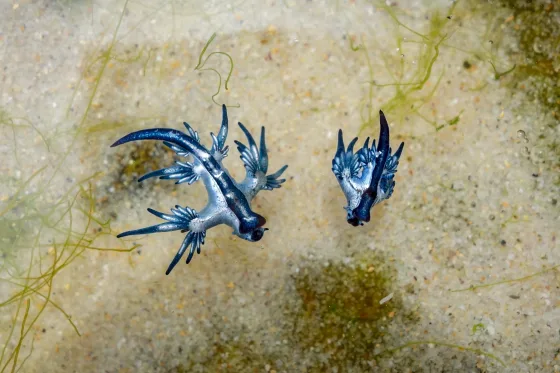While the vibrant hues of blue and silver adorning sea slugs might seem captivating, researchers caution against underestimating their potential dangers.
As Texas beaches prepare to welcome spring breakers, a fascinating spectacle awaits those who venture close to the shore: the elusive blue dragon sea slug, adorned in vibrant hues of blue and silver.
Despite their petite size, measuring only about an inch, these creatures hold a secret sting, a warning that researchers emphasize to heed.
Jace Tunnell, a marine biologist from Texas A&M University-Corpus Christi, recounts tales of unwitting encounters with these slugs, cautioning against the impulse to handle them. “There’s all kinds of stories…squeezing them and getting stung. And yeah, it doesn’t end well,” he advises.
Blue dragons, scientifically known as Glaucus atlanticus, ride the ocean’s surface, feasting on toxins from prey like the Portuguese man-of-war. With the arrival of spring winds, these mesmerizing slugs are swept ashore, potentially exposing beachgoers to their potent venom.
“The pain from a blue dragon sting can be 3 to 5 times more intense than that of a man-of-war sting,” Tunnell explains, drawing attention to the severe discomfort it can cause for hours.
Their presence is not confined to familiar waters. Climate change may be influencing their migration patterns, expanding their territory across oceans.
“While warming temperatures are a likely factor, we’ve observed the blue dragon’s range gradually expanding,” Tunnell notes.
Yet, beyond environmental shifts, heightened awareness plays a role in their increasing sightings. Unbeknownst to many, these slugs pose a threat even after washing ashore, a fact that has led to unfortunate encounters.
However, beach enthusiasts like Hannah Storbeck exercise caution. “It is cool looking, but I have heard that they’re really dangerous,” she remarks.
Indeed, a blue dragon’s sting can induce nausea and disorientation, necessitating immediate medical attention. Response to the venom varies, underscoring the need for vigilance.
In the event of a sting, experts advise applying vinegar or warm water to the affected area, refraining from abrasive substances like sand or ocean contact.
Parents, especially, are urged to educate their children on the dangers posed by blue dragons, emphasizing the importance of avoiding contact without adult supervision.
“Capture the moment safely,” suggests Tunnell. “But never risk touching it.”
